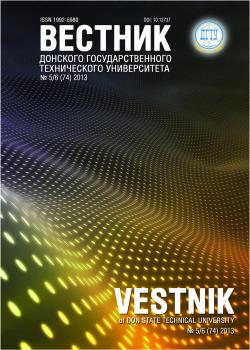Primary channels of the energy dissipation under friction and material cutting are considered. On the basis of the known testing data, it is shown that not all the energy released in these processes is spent on the wear process with the formation of wear particles. A new approach is used to calculate friction and wear characteristics. Proposed dependences differ from the known ones in that they to the fuller extent take into account the quantity of the friction energy “responsible” for the deterioration.The known approaches to assess the energy balance under friction and cutting are analyzed. The relationship between the surface energy and absorbed energy of materials is shown through comparing energy (thermal) costs in macrovolumes and on the actual contact spots. A quantity of energy “responsible” for wear is estimated in the first approximation.
friction energy balance, absorbed energy, wear-out rate, friction energy coefficient, “responsible” for wear.
Введение.Процесс изнашивания инструментальных режущих материалов, в том числе твёрдых сплавов, сопровождается интенсивным тепловыделением, и высокие температуры в инструменте в принципе определяют протекание диффузионных и окислительных процессов и стойкость инструмента.
В теоретических формулах для расчёта интенсивности изнашивания в этих условиях должна быть учтена доля энергии, запасённой изнашиваемым объёмом материала (инструмента), в виде простых зависимостей, адекватно отображающих процесс трения и износа. Это имеет важное научно-практическое значение, так как позволяет априори оценить износостойкость материалов пары трения и прогнозировать её работоспособность.
1. Ryzhkin, А. А. Obrabotka materialov rezaniem: fizicheskie osnovy. [Material-cutting technolo-gy : physical fundamentals.] Rostov-on-Don : DSTU Publ. Centre, 1995, 242 p. (in Russian).
2. Ryzhkin, А. А. Teplofizicheskie protcessy pri iznashivanii instrumentalnykh rezhushchikh ma-terialov. [Thermophysical processes under wear of tool cutting materials.] Rostov-on-Don : DSTU Publ. Centre, 2005, 311 p. (in Russian).
3. Kuznetsov, V. D. Fizika tverdogo tela. [Solid State Physics.] Tomsk : Poligrafizdat, 1947, vol. 4, 542 p. (in Russian).
4. Yepifanov, G. I., Rebinder, P. A. Ob energeticheskom balanse protcessa rezaniia metallov. [On energy balance of the metal cutting process.] Doklady Akademii nauk SSSR, 1949, vol. 66, no. 4, pp. 32-40 (in Russian).
5. Khrushchov, М. М., Babichev, M. A. Issledovaniia iznashivaniia metallov. [Studies on metal wear.] Moscow : Izdatelskii tcentr Akademii nauk SSSR, 1960, 351 p. (in Russian).
6. Kuznetsov, V. D. Poverkhnostnaia energiia tverdykh tel. [Surface energy of solids.] Moscow : Gostekhizdat, 1954, 220 p. (in Russian).
7. Troyanovskiy, Е. А. Sviaz poverkhnostnoi energii metallov s mikrotverdostiu. [Relationship be-tween the metal surface energy and microhardness.] Trudy MEI, 1975, iss. 213, pp. 44-49 (in Russian).
8. Kunin, L. L. O formulakh dlia vychisleniia poverkhnostnogo natiazheniia metallov. [On formulas for calculating metal surface tension.] Doklady Akademii nauk SSSR, 1952, vol. 79, no. 1, pp. 93-96 (in Russian).
9. Demchenko, V. V., Khomutov, N. E. O vzaimnoi sviazi raboty vykhoda elektrona s poverkh-nostnym natiazheniem. [On mutual relation of the electronic work function and surface tension.] Trudy MKhTI im. D. I. Mendeleeva, 1962, iss. 39, p. 115 (in Russian).
10. Semenchenko, V. K. Poverkhnostnye iavleniia v metallakh i splavakh. [Surface phenomena in metals and alloys.] Moscow : Gostekhizdat, 1957, 491 p. (in Russian).
11. Karapetyants, М. K. Khimicheskaia termodinamika. [Chemical Thermodynamics.] Moscow : Khimiia, 1975, 584 p. (in Russian).
12. Kostetskiy, B. I. Trenie, smazka i iznos v mashinakh. [Friction, lubrication, and wear in ma-chines.] Kiev : Tekhnika, 1970, 396 p. (in Russian).
13. Kostetskiy, B. I., et al. Poverkhnostnaia prochnost materialov pri trenii. [Surface strength of materials under friction.] Kiev : Tekhnika, 1976, 296 p. (in Russian).
14. Kostetskiy, B. I. O roli vtorichnykh struktur v formirovanii mekhanizmov treniia smazochnogo deistviia i iznashivaniia. [On role of secondary structures in developing mechanisms of lubricity friction and wear.] Trenie i iznos, 1980, vol. 1, no. 4, pp. 622-637 (in Russian).
15. Daniyelyan, А. М. Teplota i iznos instrumentov v protcesse rezaniia. [Heat and tool wear under cutting.] Moscow: Mashgiz, 1954, 276 p. (in Russian).
16. Daniyelyan, А. М. Teplovoi balans pri rezanii titanovogo splava VT-2. [Heat balance under ti-tanium alloy VT-2 cutting.] Vestnik mashinostroeniia, 1957, no. 1, pp. 15-18 (in Russian).
17. Daniyelyan, А. М., et al. Obrabotka rezaniyem zharoprochnykh staley, splavov i tugoplavkikh metallov. [Machining of heat-resistant steels, alloys, and refractory metals.] Moscow: Mashinostroenie, 1968, 308 p. (in Russian).
18. Belousov, A. I., et al. Teplovye iavleniia i obrabatyvaemost rezaniem aviatcionnykh materi-alov. [Thermal phenomena and machinability of aviation materials.] Moscow : Mashinostroenie, 1966, 180 p. (in Russian).
19. Granovskiy, G. I., Granovskiy, V. G. Rezanie metallov. [Metal cutting.] Moscow : Vysshaia shkola, 1985, 304 p. (in Russian).
20. Vasin, S. A., Vereshchaka, A. S., Kushner, V. S. Rezanie materialov. [Material cutting.] Moscow : Izdatelstvo MGTU im. Baumana, 2001, 447 p. (in Russian).
21. Yashcheritsyn, P. I., Feldstein, E. E., Korniyevich, M. A. Teoriia rezaniia. [Cutting theory.] Minsk : Novoe izdanie, 2007, 512 p. (in Russian).
22. Chichinadze, А. V. Raschet i issledovanie vneshnego treniia pri tormozhenii. [Calculation and study of friction under braking.] Moscow : Nauka, 1967, 231 p. (in Russian).
23. Ryzhkin, А. А., et al. Sposob opredeleniia optimalnoi skorosti rezaniia: a. s. 983512 SSSR. [Method for determining the optimum cutting speed: invention certificate 983512 USSR.] Bull. no. 47, 1982, 5 p. (in Russian).
24. Ryzhkin, А. А., et al. Termodinamicheskii podkhod k raschetu intensivnosti okislitelnogo iznashivaniia tverdykh splavov. [Thermodynamic approach to calculating oxidative wear intensity of hard alloys.] Vestnik RGUPS, 2012, no. 1, pp. 28-38 (in Russian).





